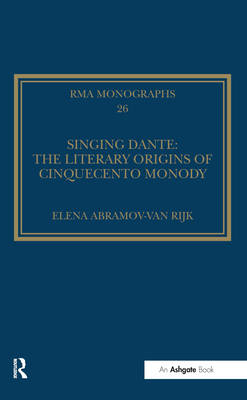
- Afhalen na 1 uur in een winkel met voorraad
- Gratis thuislevering in België vanaf € 30
- Ruim aanbod met 7 miljoen producten
- Afhalen na 1 uur in een winkel met voorraad
- Gratis thuislevering in België vanaf € 30
- Ruim aanbod met 7 miljoen producten
Singing Dante: The Literary Origins of Cinquecento Monody
Elena Abramov-Van Rijk
€ 182,45
+ 364 punten
Omschrijving
This book takes its departure from an experiment presented by Vincenzo Galilei before his colleagues in the Florentine Camerata in about 1580. This event, namely the first demonstration of the stile recitativo, is known from a single later source, a letter written in 1634 by Pietro dei Bardi, son of the founder of the Camerata. In the complete absence of any further information, Bardi's report has remained a curiosity in the history of music, and it has seemed impossible to determine the true nature and significance of Galilei's presentation. That, unfortunately, still remains true for the music, which is lost. Yet we know a crucial fact about this experiment, the poetic text chosen by Galilei: it was an excerpt from the Divine Comedy by Dante Alighieri, the Lament of Count Ugolino. Starting from this information the author examines the problem from another angle. Investigation of the perception of Dante's poetry in the sixteenth century, as well as a deeper enquiry into cinquecento poetic theories (and especially phonetics) leads to a reconstruction of Galilei's motives for choosing this text and sheds light on some of the features of his experiment.
Specificaties
Betrokkenen
- Auteur(s):
- Uitgeverij:
Inhoud
- Aantal bladzijden:
- 150
- Taal:
- Engels
- Reeks:
Eigenschappen
- Productcode (EAN):
- 9781472437990
- Verschijningsdatum:
- 4/11/2014
- Uitvoering:
- Hardcover
- Formaat:
- Genaaid
- Afmetingen:
- 150 mm x 244 mm
- Gewicht:
- 453 g

Alleen bij Standaard Boekhandel
+ 364 punten op je klantenkaart van Standaard Boekhandel
Beoordelingen
We publiceren alleen reviews die voldoen aan de voorwaarden voor reviews. Bekijk onze voorwaarden voor reviews.









